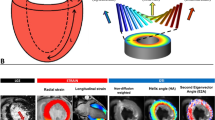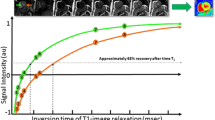Abstract
Objectives
To investigate the accuracy of post-mortem diffusion tensor imaging (DTI) for the detection of myocardial infarction (MI) and to demonstrate the feasibility of helix angle (HA) calculation to study remodelling of myofibre architecture.
Methods
Cardiac DTI was performed in 26 deceased subjects prior to autopsy for medicolegal reasons. Fractional anisotropy (FA) and mean diffusivity (MD) were determined. Accuracy was calculated on per-segment (AHA classification), per-territory, and per-patient basis, with pathology as reference standard. HAs were calculated and compared between healthy segments and those with MI.
Results
Autopsy demonstrated MI in 61/440 segments (13.9 %) in 12/26 deceased subjects. Healthy myocardial segments had significantly higher FA (p < 0.01) and lower MD (p < 0.001) compared to segments with MI. Multivariate logistic regression demonstrated that FA (p < 0.10) and MD (p = 0.01) with the covariate post-mortem time (p < 0.01) predicted MI with an accuracy of 0.73. Analysis of HA distribution demonstrated remodelling of myofibre architecture, with significant differences between healthy segments and segments with chronic (p < 0.001) but not with acute MI (p > 0.05).
Conclusions
Post-mortem cardiac DTI enablesdifferentiation between healthy and infarcted myocardial segments by means of FA and MD. HA assessment allows for the demonstration of remodelling of myofibre architecture following chronic MI.
Key Points
• DTI enables post-mortem detection of myocardial infarction with good accuracy.
• A decrease in right-handed helical fibre indicates myofibre remodelling following chronic myocardial infarction.
• DTI allows for ruling out myocardial infarction by means of FA.
• Post-mortem DTI may represent a valuable screening tool in forensic investigations.




Similar content being viewed by others
Abbreviations
- CI:
-
Confidence interval
- DTI:
-
Diffusion tensor imaging
- FA:
-
Fractional anisotropy
- HA:
-
Helix angle
- HE:
-
Hematoxylin and eosin
- ICC:
-
Intraclass correlation coefficients
- MD:
-
Mean diffusivity
- MI:
-
Myocardial infarction
- MRI:
-
Magnetic resonance imaging
- NPV:
-
Negative predictive value
- PD:
-
Proton density
- PPV:
-
Positive predictive value
- ROC:
-
Receiver operating characteristics
- ROI:
-
Region of interest
References
Go AS, Mozaffarian D, Roger VL et al (2013) Heart disease and stroke statistics—2013 update: a report from the American Heart Association. Circulation 127:e6–e245
Wu Y, Wu EX (2009) MR study of postnatal development of myocardial structure and left ventricular function. J Magn Reson Imaging 30:47–53
Wu Y, Zou C, Liu W et al (2013) Effect of B-value in revealing postinfarct myocardial microstructural remodeling using MR diffusion tensor imaging. Magn Reson Imaging 31:847–856
Chen J, Song SK, Liu W et al (2003) Remodeling of cardiac fiber structure after infarction in rats quantified with diffusion tensor MRI. Am J Physiol Heart Circ Physiol 285:H946–H954
Sosnovik DE, Wang R, Dai G, Reese TG, Wedeen VJ (2009) Diffusion MR tractography of the heart. J Cardiovasc Magn Reson 11:47
Hsu EW, Muzikant AL, Matulevicius SA, Penland RC, Henriquez CS (1998) Magnetic resonance myocardial fiber-orientation mapping with direct histological correlation. Am J Physiol 274:H1627–H1634
Baglivo M, Winklhofer S, Hatch GM, Ampanozi G, Thali MJ, Ruder TD (2013) The rise of forensic and post-mortem radiology—analysis of the literature between the year 2000 and 2011. J Forensic Radiol Imaging 1:3–9
Jackowski C, Christe A, Sonnenschein M, Aghayev E, Thali MJ (2006) Postmortem unenhanced magnetic resonance imaging of myocardial infarction in correlation to histological infarction age characterization. Eur Heart J 27:2459–2467
Thali MJ, Yen K, Schweitzer W et al (2003) Virtopsy, a new imaging horizon in forensic pathology: virtual autopsy by postmortem multislice computed tomography (MSCT) and magnetic resonance imaging (MRI)—a feasibility study. J Forensic Sci 48:386–403
Eggen MD, Swingen CM, Iaizzo PA (2012) Ex vivo diffusion tensor MRI of human hearts: relative effects of specimen decomposition. Magn Reson Med 67:1703–1709
Holmes AA, Scollan DF, Winslow RL (2000) Direct histological validation of diffusion tensor MRI in formaldehyde-fixed myocardium. Magn Reson Med 44:157–161
Crooijmans HJA, Ruder TD, Zech WD et al (2013) Feasibility of quantitative diffusion imaging of the heart in post-mortem MR. J Forensic Radiol Imaging 1:124–128
Levy AD, Harcke HT, Mallak CT (2010) Postmortem imaging: MDCT features of postmortem change and decomposition. Am J Forensic Med Pathol 31:12–17
Jaermann T, Crelier G, Pruessmann KP et al (2004) SENSE-DTI at 3T. Magn Reson Med 51:230–236
Dou J, Tseng WY, Reese TG, Wedeen VJ (2003) Combined diffusion and strain MRI reveals structure and function of human myocardial laminar sheets in vivo. Magn Reson Med 50:107–113
Wheeler-Kingshott CA, Parker GJ, Symms MR et al (2002) ADC mapping of the human optic nerve: increased resolution, coverage, and reliability with CSF-suppressed ZOOM-EPI. Magn Reson Med 47:24–31
Toussaint N, Stoeck CT, Schaeffter T, Kozerke S, Sermesant M, Batchelor PG (2013) In vivo human cardiac fibre architecture estimation using shape-based diffusion tensor processing. Med Image Anal 17:1243–1255
Fillard P, Pennec X, Arsigny V, Ayache N (2007) Clinical DT-MRI estimation, smoothing, and fiber tracking with log-Euclidean metrics. IEEE Trans Med Imaging 26:1472–1482
Scollan DF, Holmes A, Winslow R, Forder J (1998) Histological validation of myocardial microstructure obtained from diffusion tensor magnetic resonance imaging. Am J Physiol 275:H2308–H2318
Cerqueira MD, Weissman NJ, Dilsizian V et al (2002) Standardized myocardial segmentation and nomenclature for tomographic imaging of the heart. A statement for healthcare professionals from the Cardiac Imaging Committee of the Council on Clinical Cardiology of the American Heart Association. Circulation 105:539–542
Roberts IS, Benamore RE, Benbow EW et al (2012) Post-mortem imaging as an alternative to autopsy in the diagnosis of adult deaths: a validation study. Lancet 379:136–142
Wu JS, Zhou LF, Tang WJ et al (2007) Clinical evaluation and follow-up outcome of diffusion tensor imaging-based functional neuronavigation: a prospective, controlled study in patients with gliomas involving pyramidal tracts. Neurosurgery 61:935–948, discussion 948-939
Nielles-Vallespin S, Mekkaoui C, Gatehouse P et al (2013) In vivo diffusion tensor MRI of the human heart: reproducibility of breath-hold and navigator-based approaches. Magn Reson Med 70:454–465
Wu MT, Tseng WY, Su MY et al (2006) Diffusion tensor magnetic resonance imaging mapping the fiber architecture remodeling in human myocardium after infarction: correlation with viability and wall motion. Circulation 114:1036–1045
Hsu EW, Xue R, Holmes A, Forder JR (1998) Delayed reduction of tissue water diffusion after myocardial ischemia. Am J Physiol 275:H697–H702
Le Bihan D, Delannoy J, Levin RL (1989) Temperature mapping with MR imaging of molecular diffusion: application to hyperthermia. Radiology 171:853–857
Healy LJ, Jiang Y, Hsu EW (2011) Quantitative comparison of myocardial fiber structure between mice, rabbit, and sheep using diffusion tensor cardiovascular magnetic resonance. J Cardiovasc Magn Reson 13:74
Strijkers GJ, Bouts A, Blankesteijn WM et al (2009) Diffusion tensor imaging of left ventricular remodeling in response to myocardial infarction in the mouse. NMR Biomed 22:182–190
Wu EX, Wu Y, Tang H et al (2007) Study of myocardial fiber pathway using magnetic resonance diffusion tensor imaging. Magn Reson Imaging 25:1048–1057
Wu MT, Su MY, Huang YL et al (2009) Sequential changes of myocardial microstructure in patients postmyocardial infarction by diffusion-tensor cardiac MR: correlation with left ventricular structure and function. Circ Cardiovasc Imaging 2:32–40, 36 p following 40
Gerdes AM, Capasso JM (1995) Structural remodeling and mechanical dysfunction of cardiac myocytes in heart failure. J Mol Cell Cardiol 27:849–856
Natali AJ, Wilson LA, Peckham M, Turner DL, Harrison SM, White E (2002) Different regional effects of voluntary exercise on the mechanical and electrical properties of rat ventricular myocytes. J Physiol 541:863–875
Kumar D, Hacker TA, Buck J et al (2005) Distinct mouse coronary anatomy and myocardial infarction consequent to ligation. Coron Artery Dis 16:41–44
Ruder TD, Hatch GM, Siegenthaler L et al (2012) The influence of body temperature on image contrast in post mortem MRI. Eur J Radiol 81:1366–1370
Acknowledgments
The scientific guarantor of this publication is Paul Stolzmann. The authors of this manuscript declare no relationships with any companies whose products or services may be related to the subject matter of the article. The authors state that this work has not received any funding. One of the authors has significant statistical expertise. Institutional Review Board approval was obtained. Written informed consent was not required for this study, as informed consent was not applicable due to the post-mortem nature of the study. Methodology: prospective diagnostic or prognostic study, performed at one institution.
Conflict on interest
No conflict of interest declared.
Author information
Authors and Affiliations
Corresponding author
Rights and permissions
About this article
Cite this article
Winklhofer, S., Stoeck, C.T., Berger, N. et al. Post-mortem cardiac diffusion tensor imaging: detection of myocardial infarction and remodeling of myofiber architecture. Eur Radiol 24, 2810–2818 (2014). https://doi.org/10.1007/s00330-014-3322-7
Received:
Revised:
Accepted:
Published:
Issue Date:
DOI: https://doi.org/10.1007/s00330-014-3322-7




